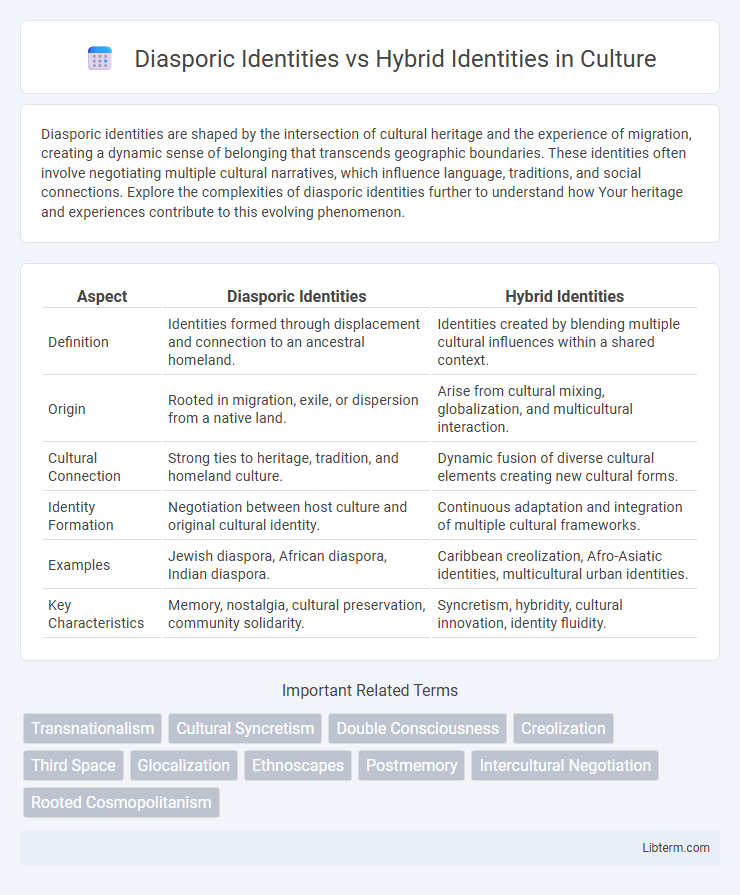Diasporic identities are shaped by the intersection of cultural heritage and the experience of migration, creating a dynamic sense of belonging that transcends geographic boundaries. These identities often involve negotiating multiple cultural narratives, which influence language, traditions, and social connections. Explore the complexities of diasporic identities further to understand how Your heritage and experiences contribute to this evolving phenomenon.
Table of Comparison
| Aspect | Diasporic Identities | Hybrid Identities |
|---|---|---|
| Definition | Identities formed through displacement and connection to an ancestral homeland. | Identities created by blending multiple cultural influences within a shared context. |
| Origin | Rooted in migration, exile, or dispersion from a native land. | Arise from cultural mixing, globalization, and multicultural interaction. |
| Cultural Connection | Strong ties to heritage, tradition, and homeland culture. | Dynamic fusion of diverse cultural elements creating new cultural forms. |
| Identity Formation | Negotiation between host culture and original cultural identity. | Continuous adaptation and integration of multiple cultural frameworks. |
| Examples | Jewish diaspora, African diaspora, Indian diaspora. | Caribbean creolization, Afro-Asiatic identities, multicultural urban identities. |
| Key Characteristics | Memory, nostalgia, cultural preservation, community solidarity. | Syncretism, hybridity, cultural innovation, identity fluidity. |
Understanding Diasporic Identities
Diasporic identities emerge from the lived experiences of individuals and communities displaced from their ancestral homelands, often characterized by a strong attachment to cultural heritage, collective memory, and a sense of belonging to a distant origin. These identities are shaped by transnational connections, historical trauma, and ongoing negotiation between preservation of original cultural norms and adaptation to host societies. Understanding diasporic identities involves recognizing the dynamic interplay between memory, place, and identity formation within the context of migration and globalization.
Defining Hybrid Identities
Hybrid identities emerge from the blending of multiple cultural backgrounds, reflecting the complex, dynamic nature of modern identity formation. Unlike diasporic identities, which often emphasize a connection to a specific homeland, hybrid identities embody fluid intercultural interactions, resulting in new, evolving cultural expressions. This concept highlights how individuals navigate and integrate diverse cultural influences, creating unique, multifaceted personal and social identities.
Historical Context of Diasporic Experiences
Diasporic identities stem from historical forced or voluntary migrations, often marked by displacement, colonialism, and socio-political upheavals that shape collective memory and cultural retention among dispersed communities. Hybrid identities emerge from ongoing intercultural exchanges and syncretism in postcolonial and globalized contexts, reflecting fluid and negotiated self-conceptions that transcend singular ethnic or national affiliations. The historical context of diasporic experiences underscores the tension between preservation of origin and adaptation to new environments, illustrating complex identity formations influenced by trauma, resilience, and transnational connections.
Cultural Negotiation in Diaspora
Diasporic identities involve individuals maintaining connections to their ancestral culture while adapting to new social environments, reflecting ongoing cultural negotiation in diaspora communities. Hybrid identities emerge through the fusion of multiple cultural influences, creating new, dynamic cultural expressions that transcend traditional boundaries. This cultural negotiation fosters resilience and innovation, enabling diasporic individuals to navigate complex social landscapes and construct multifaceted identities.
Formation of Hybrid Identities in Globalized Societies
Formation of hybrid identities in globalized societies arises through frequent intercultural interactions and the blending of diverse cultural norms, languages, and traditions. Diasporic identities, rooted in the memory and preservation of homeland culture, gradually evolve as individuals integrate new cultural elements from host societies. This dynamic interplay fosters complex hybrid identities characterized by fluidity, multiplicity, and adaptation within transnational contexts.
Identity Conflict and Belonging
Diasporic identities often experience persistent identity conflict due to the tension between maintaining their ancestral heritage and integrating into a new cultural environment. Hybrid identities emerge from the blending of multiple cultural influences, creating fluid and dynamic senses of belonging that challenge traditional notions of fixed identity. The struggle between preserving original cultural roots and adapting to new social contexts underscores the complexity of belonging in both diasporic and hybrid identity frameworks.
Language, Memory, and Identity Formation
Diasporic identities often emphasize the preservation of native languages and collective memory as key elements in maintaining a distinct cultural identity amid displacement. Hybrid identities, by contrast, emerge through the intermingling of multiple languages and memories, resulting in fluid, multifaceted identity formations that challenge traditional cultural boundaries. Language serves as both a repository of memory and a dynamic tool in identity construction, shaping how individuals negotiate belonging within diasporic and hybrid contexts.
Diasporic vs Hybrid: Intersections and Divergences
Diasporic identities are rooted in the collective memory and shared history of displacement, emphasizing connections to an original homeland, while hybrid identities emerge from the blending of multiple cultural influences in diaspora and host societies. The intersection lies in both identities negotiating belonging and cultural negotiation, yet diasporic identities prioritize preservation and reclamation, whereas hybrid identities celebrate fluidity and cultural fusion. Divergences include diasporic identities often resisting assimilation, upholding distinct traditions, whereas hybrid identities embrace ongoing transformation and synthesis across cultural boundaries.
Representation in Media and Literature
Diasporic identities in media and literature emphasize connections to ancestral homelands, highlighting themes of displacement, cultural preservation, and belonging. Hybrid identities showcase the fusion of multiple cultural influences, reflecting fluid and evolving self-conceptions shaped by globalization and multicultural experiences. Representation of both identities challenges monolithic narratives, offering nuanced portrayals that address the complexities of cultural negotiation and identity formation.
Future Perspectives on Identity Construction
Diasporic identities often emphasize connections to ancestral homelands, fostering a sense of belonging rooted in cultural preservation and historical memory. Hybrid identities, by contrast, emerge from the dynamic blending of multiple cultural influences, reflecting adaptability and the fluidity of self in globalized contexts. Future perspectives on identity construction suggest increasing recognition of these multifaceted identities as individuals navigate transnational spaces, digital networks, and evolving sociopolitical landscapes, shaping more inclusive and layered understandings of belonging.
Diasporic Identities Infographic

 libterm.com
libterm.com